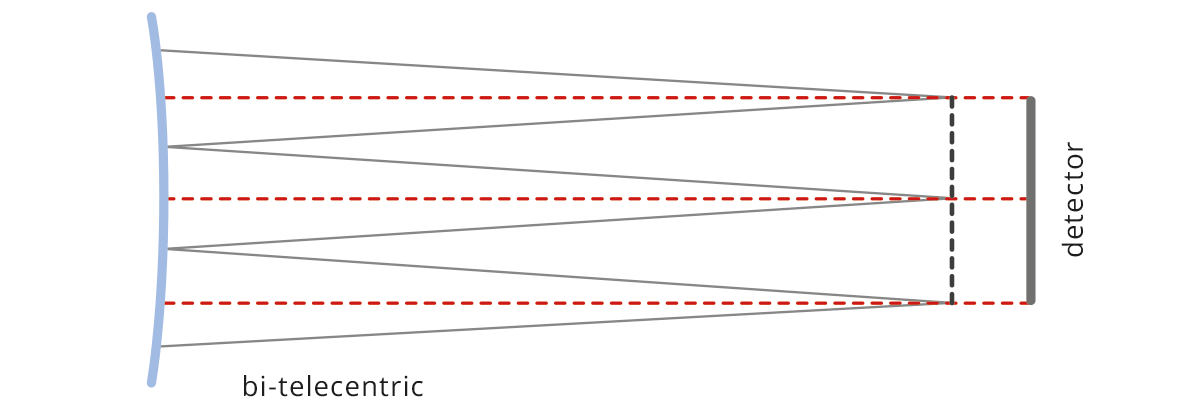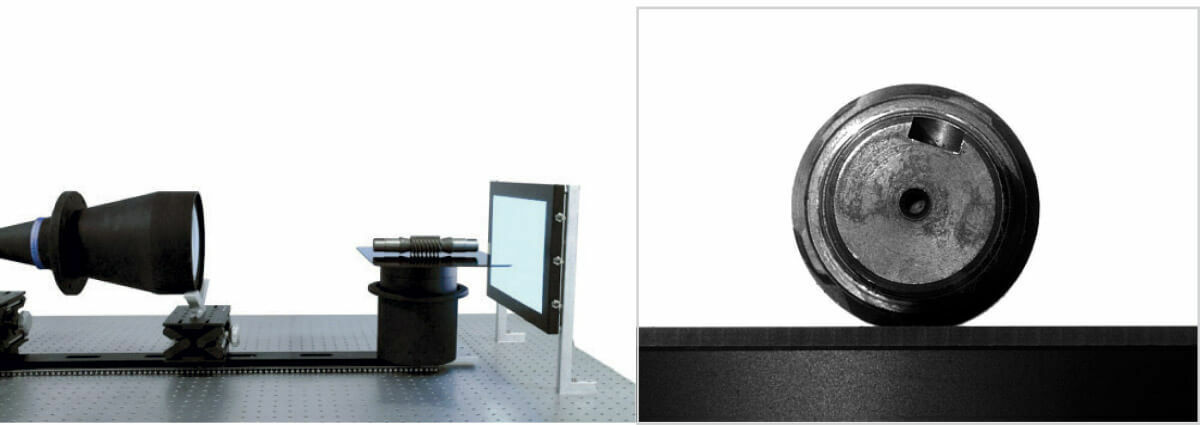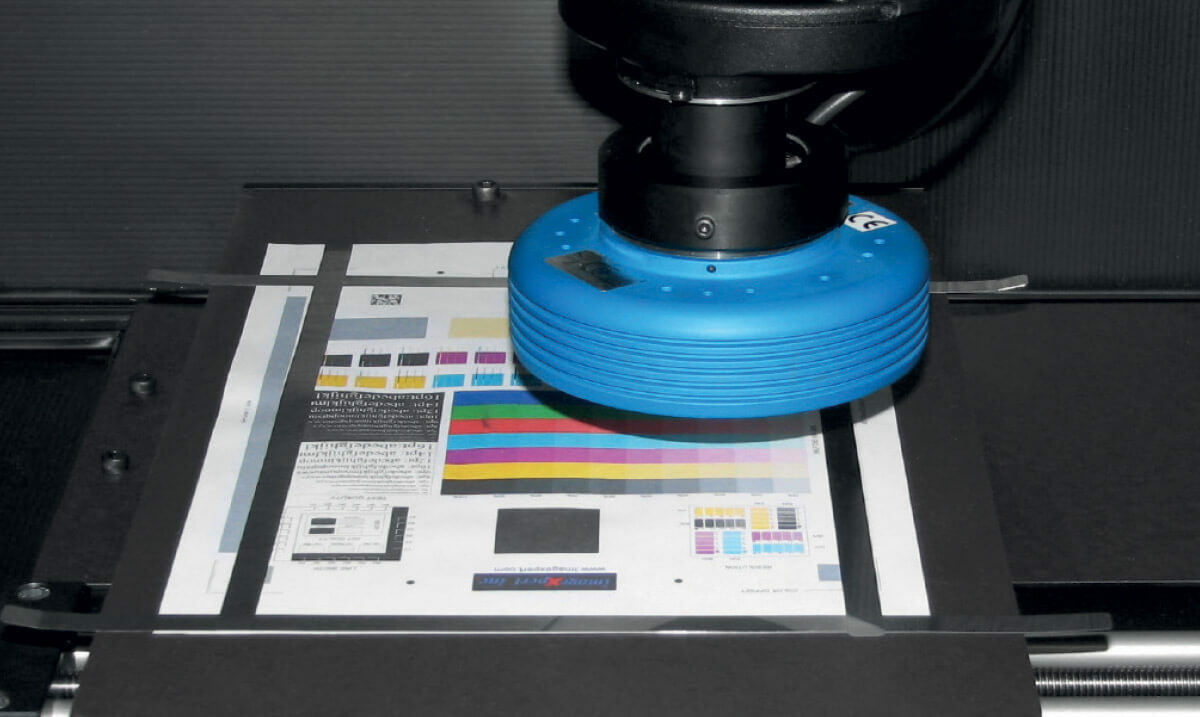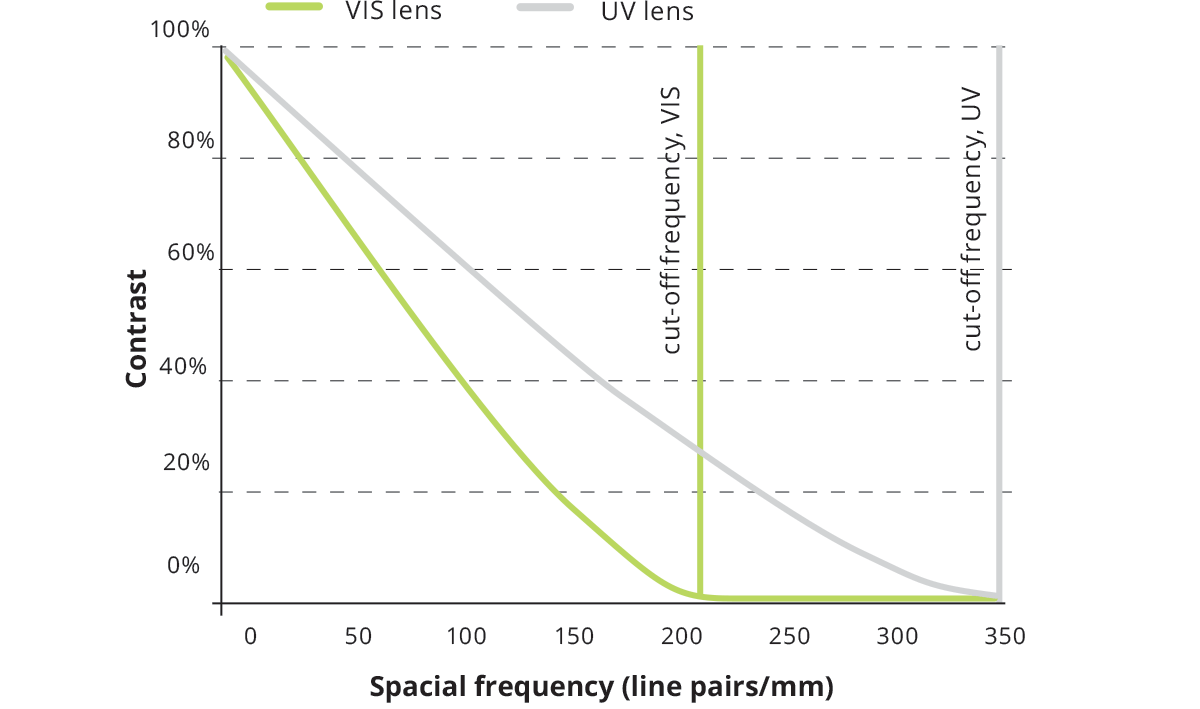Telecentric lenses
Telecentric lenses
Telecentric lenses represent a special class of optics designed to only collect collimated light ray bundles (i.e. parallel to the optical axis, see picture), thus eliminating perspective errors.
Since only rays parallel to the optical axis are accepted, the
magnification of a telecentric lens is independent of the object
location. This unique feature makes telecentric lenses perfectly suited
for measurement applications, where perspective errors and changes in
magnification can lead to inconsistent measurements. Because of its
design, the front element of a telecentric lens must be at least as
large as the desired FOV, making these lenses inadequate to image very
large objects.
The drawings show the difference between common optics (entocentric) and telecentric lenses. Fixed focal length lenses are entocentric lenses, meaning that they collect rays diverging from the optical axis. This allows them to cover large FoVs but since magnification is different at different working distances, these lenses are not suited to determine the true dimensions of an object.
Better Magnification Constancy
Standard telecentric lenses accept ray cones whose axis is parallel to the main optical axis; if the lens is only telecentric in object space, ray cones passing through the optical system reach the detector from different angles depending upon the field position. Moreover, the optical wavefront is completely asymmetric since incoming telecentric rays become non-telecentric in image space. As a consequence, the spots generated by ray cones on the detector plane change in shape and dimension from point to point in image space (the point-spread function becomes non-symmetrical and a small circular spot grows larger and turns elliptical as you move from the image center towards the borders).
Even worse, when the object is displaced, rays coming from a certain field point generate a spot that moves back and forth over the image plane, thus causing a significant change in magnification. For this reason, non-bi-telecentric lenses show a lower magnification constancy although their telecentricity might be very good if measured only in the object space. Bi-telecentric lenses are telecentric in both object and image space, which means that principal rays are parallel not only when entering but also when exiting the lens. This feature is essential to overcome all the accuracy issues concerned with mono-telecentric lenses such as point spread function inhomogeneity and lack of magnification constancy through the field depth.


Increased field depth
Field depth is the maximum acceptable displacement of an object from its best focus position. Beyond this limit, the image resolution becomes poor, because the rays coming from the object can’t create sufficiently small spots on the detector: blurring effect occurs because geometrical information carried by the optical rays spread over too many image pixels.
Depth of field basically depends upon the optics F/#, which is inversely proportional to the lens aperture diameter: the higher the f-number the larger the field depth, with a quasi-linear dependence. Increasing the F/# reduces ray cones divergence, allowing for smaller spots to form onto the detector; however, raising the F/# over certain values introduces diffraction effects which limit the maximum achievable resolution.
Bi-telecentricity is beneficial in maintaining a very good image contrast even when looking at very thick objects (see Fig. 34): the symmetry of the optical system and the rays parallelism help the image spots with staying symmetrical, which reduces the blur effect. This results in a field depth being perceived as 20-30% larger compared to non-bi-telecentric optics.

Even detector illumination
Bi-telecentric lenses boast a very even illumination of the detector,
which comes useful in several applications such as LCD, textile and
print quality control. When dichroic filters have to be integrated in
the optical path for photometric or radiometric measurements,
bi-telecentricity assures that the ray fan axis strikes the filter
normal to its surface, thus preserving the optical band-pass over the
whole detector area.

How to choose the right telecentric lens
Having fixed working distance and aperture, telecentric lenses are classified by their magnification and image circle. Choosing the right telecentric lens is easy: we must find the magnification under which the image fit the sensor.
Example. We need to measure the geometrical feature of a mechanical part (nut) using a telecentric lens and a 2048 x 2048, 5.5 µm sensor. The nut is inscribed in a 10 mm diameter circle with 2 mm uncertainty on the sample position. What is the best choice?
Given the camera resolution and pixel size (2048 x 2048 pix, 5.5 µm), the sensor dimensions are calculated to be 11.26 x 11.26 mm.
The FOV must contain a 12 mm diameter circle, hence the minimum magnification required is 0.938X.
The Opto Engineering® TC23009 telecentric lens (M=1.000X, image circle 11 mm) would give a FOV of 11.26 mm x 11.26 mm, but because of mechanical vignetting the actual FOV is only an 11 mm diameter circle. In this case, if a more accurate part placement cannot be guaranteed, a lens with a lower mag or a larger image circle must be chosen. Using the Opto Engineering® TC2MHR016-x lens (M=0.767X, image circle 16.0 mm) we find a FOV of 14.68 x 14.68 mm which is a very close match.
UV telecentric optics
Since the diffraction limit allows higher resolution at shorter wavelengths (see Fig. 36), UV optics can reach superior results compared to standard lenses and can efficiently operate with pixels as small as 1.75 µm. For example, the Opto Engineering® TCUV series telecentric lenses operate in the near UV range and deliver extremely high resolution for very demanding measurement applications.

Why Opto Engineering® telecentric lenses do not integrate an iris?
Our TC lenses don’t feature an iris, but we can easily adjust the aperture upon request prior to shipping the lens, without any additional costs or delays for the customer. The reasons why our lenses don’t feature an iris are so many that the proper question would be why other manufacturers do integrate irises?
- adding an iris makes a lens more expensive because of a feature that would only be used once or twice throughout the product life
- iris insertion makes the mechanics less precise and the optical alignment much worse
- we would be unable to test the lenses at the same aperture that the customer would be using
- iris position is much less precise than a metal sheet aperture: this strongly affects telecentricity
- the iris geometry is polygonal, not circular: this changes the inclination of the main rays across the FOV, thus affecting the lens distortion and resolution
- irises cannot be as well centered as fixed, round, diaphragms: proper centering is essential to ensure a good telecentricity of the lens
- only a circular, fixed, aperture makes brightness the same for all lenses
- an adjustable iris is typically not flat and this causes uncertainty in the stop position, which is crucial when using telecentric lenses!
- iris is a moving part that can be dangerous in most industrial environments. Vibrations could easily disassemble the mechanics or change the lens aperture
- the iris setting can be accidentally changed by the user and that would change the original system configuration
- end-users prefer having fewer options and only a few things that have to be tuned in a MV system
- apertures smaller than what is delivered by OE as a standard will not make sense as the resolution will decay because of diffraction limit; on the other hand, much wider apertures would cause a reduction of the field depth.
- the standard aperture of OE lenses is meant to optimize image resolution and field depth.
Why Opto Engineering® telecentric lenses do not feature a focusing mechanism?
As with the iris, a focusing mechanism would generate a mechanical play in the moving part of the lens, thus making it worse the centering of the optical system and also causing trapezoidal distortion.
Another issue is concerned with radial distortion: the distortion of a telecentric lens can be kept small only when the distances between optical components are set at certain values: displacing any element from the correct position would increase the lens distortion. A focusing mechanism makes the positioning of the lenses inside the optical system uncertain and the distortion value unknown: the distortion would then be different from the values obtained in our quality control process.
